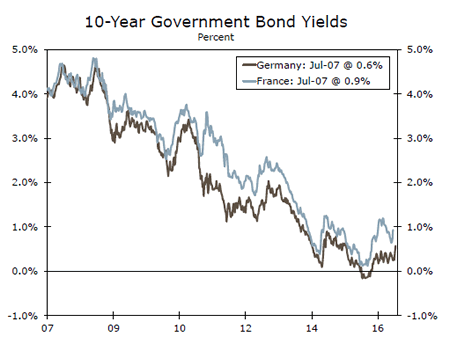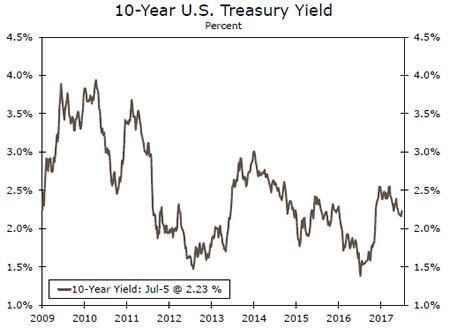U.S. Review
Economic Data Suggest Stronger Growth in Q2
- The ISM manufacturing index kicked off the fireworks a day early on Monday with its highest reading since August 2014. The ISM non-manufacturing index also topped expectations.
- The FOMC minutes from the June meeting showed that the Fed appeared split on when to initiate the beginning of its balance sheet reduction program. We anticipate the reductions will begin at the start of Q4, with the next rate hike occurring in December.
- Nonfarm payrolls capped the strong week with a 222,000 increase in employment. Despite the job gains, wage growth remained stuck in neutral.
Economic Data Suggest Stronger Growth in Q2
Economic data in the United States this week were supportive of stronger economic growth. The ISM manufacturing index kicked off the fireworks a day early on Monday, climbing to 57.8 in June. This was the best print for the index since August 2014 when oil was still nearly $100 a barrel.
The details of the report were broadly encouraging for both current and future activity. The production subcomponent rose to 62.4 from 57.1, and only two industries (apparel, leather & allied products and textile mills) indicated that production declined last month. In addition, the employment subcomponent rose to a three-month high of 57.2. The new orders, backlog of orders and new export orders subcomponents all increased in the month, which bodes well for momentum in the factory sector headed into Q3. The ISM’s services counterpart also topped expectations in June, albeit in a less dramatic fashion. The non-manufacturing index climbed to 57.4 from 56.9 in May, spurred by a pick-up in new orders. Taken together, these survey-based measures of economic activity are near multi-year highs, which bode well for economic growth in the near-term (top chart).
The U.S. trade deficit narrowed in May, reflecting an $855 million increase in exports and a $223 million decline in imports. Taking a longer term view, export growth has returned to positive territory after dipping into negative territory last year (middle chart). The collapse in commodity prices depressed the value of industrial exports while deceleration in global economic activity last year weighed on other categories of exports. The stabilization in commodity prices and stronger economic growth in many of the nation’s major trading partners are giving a boost to the value of American exports this year.
The minutes from the June FOMC meeting painted the picture of a Fed that continues to hold its cards close to its chest. There continued to be little clarity around the timing of changes to the Fed’s reinvestment policy, with some participants preferring to start the process within a couple months, whereas others supported holding off until later in the year. The reaction to the FOMC minutes was generally mild, with the selloff in U.S. Treasuries this week driven more by the economic data and foreign developments (see the Topic of the Week on page 7). We are of the view that the next fed funds increase will occur in December. At the September meeting, we expect the Fed to refrain from raising rates as it officially announces its balance sheet reduction program, which, in our view, will begin a few weeks later at the start of Q4.
Employers added 222,000 net new jobs in June, the second strongest print of 2017. Job gains were broad-based, with healthy hiring in construction, government and leisure & hospitality. The unemployment rate rose a tick to 4.4 percent amid a 361,000 person surge in the labor force. The major weak spot in the report was another sideways print for average hourly earnings growth (bottom chart). The lack of a marked acceleration in earnings reinforces our belief that the Fed will maintain its slow and steady approach to tightening policy in the months ahead.
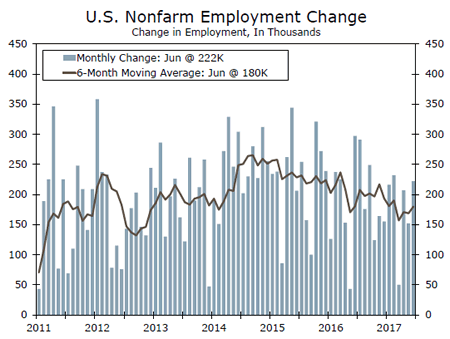


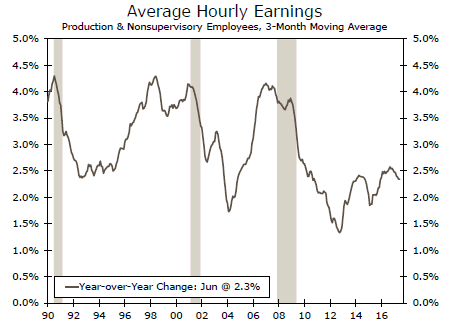
U.S. Outlook
CPI • Friday
Inflation measures have come in below expectations in recent months, and prices declined in May in both the CPI and the PCE deflator. Year-over-year comparisons continue to drift lower from the Fed’s 2 percent target. Transitory factors are certainly at play, including lower gasoline prices and wireless cell phone plans, though weakness has broadened into core price categories as well. Apparel, transportation and medical care all posted lower readings in May. The weakness in the core CPI trend is evident in the three-month annualized pace, which fell to zero in May.
Continued misses from incoming inflation data prompted us to reevaluate our outlook for monetary policy moves through the end of the year. We moved our call for the next funds rate hike from September to December, and expect the FOMC to initiate balance sheet reductions in September.
Previous: -0.1 % Wells Fargo: 0.1% Consensus: 0.1 % (Month-over-Month)

Retail Sales • Friday
After a disappointing showing in the first quarter of the year, we are looking to retail sales for hints of a strong rebound for consumer spending in Q2. The strength of said resurgence was challenged by the May retail sales report, which showed a decline of 0.3 percent on the month. Lower gasoline prices were a contributor to the soft read, though not the only culprit. Auto sales continued to weigh on retailers, and paltry performances in other sectors were unable to compensate. Sales were down at electronics and sporting goods stores, department stores and eating & drinking places. These categories tend to reflect consumers’ discretionary spending, so continued weakness here may be a red flag that consumers are pulling back.
Control group sales, which go into GDP calculations, were flat in May but up strongly in April. We will look closely at this category in June to gauge the strength of the Q2 rebound in personal spending.
Previous: -0.3 % Wells Fargo: 0.1% Consensus: 0.2 % (Month-over-Month)
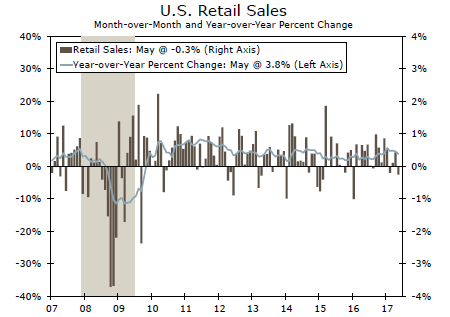
Industrial Production • Friday
A flat reading for industrial production in May was the result of increased production in utilities and mining offsetting a 0.4 percent dip in manufacturing output. Manufacturing output declined in two of the past three months, bringing the sector’s three-month annualized growth rate to zero. The slowdown in auto production was only partially at play, as factory output still declined 0.2 percent when motor vehicles and parts were excluded.
The May manufacturing production report was another hard data point suggesting that the factory sector is expanding at a much slower pace than indicated by recent survey measures. Orders and shipments data releases in recent weeks reiterated that story. The ISM manufacturing survey, however, again suggested a more robust pace of expansion in June. Our forecast contains a healthy degree of skepticism for the factory sector, but we expect a gradual lift in activity, as the hard data continue to suggest.
Previous: 0.0 % Wells Fargo: 0.4% Consensus: 0.3 % (Month-over-Month)
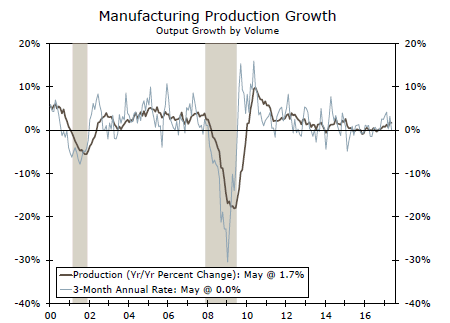
Global Review
Solid Growth in Many Foreign Economies in Q2
- The Tankan survey of Japanese business sentiment corroborated other recent data that suggest the Japanese economy continues to grind along. Real GDP growth in the second quarter appears to have been solid as well in the Eurozone and in Canada.
- In contrast, economic growth in the United Kingdom appears to be lackluster at present. Although there are a number of reasons behind the recent slowdown in the U.K. economy, uncertainties related to the Brexit process undoubtedly are playing a role.
Solid Growth in Many Foreign Economies in Q2
We reported in this space last week that incoming data show that the Japanese economy continues to grind along at a modest pace. The Tankan survey of Japanese business sentiment, which was released early this week, corroborated the message from these previous data releases. As shown in the graph on the front page, the "headline" index, which measures sentiment among large manufacturers, rose in the second quarter to its highest level in more than three years. Other details within the survey were also generally encouraging. Analysts scrutinize the survey data because the "headline" index has a fair degree of correlation with Japanese GDP growth. Bottom line: the Japanese economy continues to grind along at a modest pace.
As measured by the U.K. purchasing managers’ indices, the British economy appears to be grinding higher as well at present. Both the manufacturing and service sectors PMIs remain above the demarcation line separating expansion from contraction (top chart). Yet neither index is at a level that would suggest the economy is "booming." Indeed, hard data that were released this week showed that growth in the British economy remains lackluster. In May, industrial production (IP) fell 0.1 percent relative to the previous month, pulling the year-over-year growth rate down to -0.2 percent. The construction sector was also weak as output dropped 1.2 percent on a sequential basis in May. Although there are a number of reasons behind the recent slowdown in the U.K. economy, uncertainties related to the Brexit process undoubtedly are playing a role.
In contrast to the slowdown that is underway in the United Kingdom, economic activity in the Eurozone appears to be strengthening. IP in Germany jumped 1.2 percent in May. On a year-ago basis, IP growth rose to 6-year high of 5.0 percent (middle chart). French IP was also much stronger than expected, rising 1.9 percent on a sequential basis in May. As we discuss in the Topic of the Week (page 7), the recent run of stronger-thanexpected economic data in the Eurozone has contributed to the recent surge in government bond yields in the euro area.
The Canadian economy also appears to have a fair amount of momentum behind it. Payrolls in Canada rose by 45,300 in June (bottom chart). Not only was the outturn significantly stronger than the consensus forecast, but it follows on the heels of the 54,400 jobs that were created in May. Over the past six months, payrolls have risen by 31,000 per month, on average. (This is equivalent to over 300,000 per month in the United States.) The strong rise in employment pushed the unemployment rate down to 6.5 percent in June from 6.6 percent in May.
At 1.3 percent in May, CPI inflation in Canada is well below the midpoint of the Bank of Canada’s (BoC) target range of 1 percent to 3 percent. Nevertheless, we look for the BoC to hike its main policy rate by 25 bps at its policy meeting on July 12. Real GDP in Canada has accelerated in recent quarters, and all indications are that growth in the second quarter was solid. Furthermore, BoC policymakers have been signaling in recent comments that higher rates are on the way.

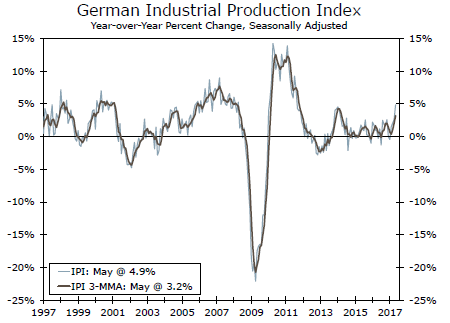
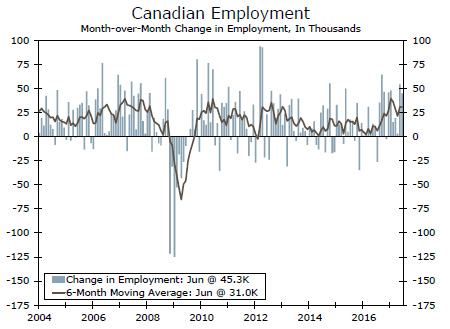
Global Outlook
Eurozone Ind. Production • Wednesday
The Eurozone industrial production index has not delivered three consecutive positive month-on-month growth rates since the second half of 2013. The index will have an opportunity next week of matching such a streak when it is released on Wednesday. As we know, the Eurozone industrial production index is highly dependent on what is happening in Germany, the largest economy of the Eurozone. With the strong showing for Germany’s industrial production index released today, up a strong 1.2 percent, month on month, and the also strong, up 1.9 percent, for France’s industrial production index, the expectation is for the Eurozone industrial production index to come in strong in May also.
Consensus is expecting a strong, 1.0 percent increase in the index, with a clear risk to the upside given the strong showings for the largest economies of the region.
Previous: 0.5% Consensus: 1.0% (Month-over-Month)
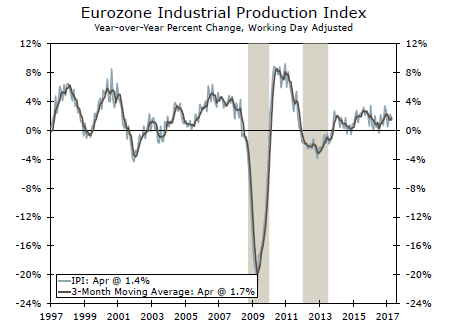
Mexico Ind. Production • Wednesday
The Mexican economy, so far, has surprised on the upside this year. However, some data points, especially on gross fixed investment and confidence, have disappointed. Thus, a good industrial production number for May, which is going to be released on Wednesday, will help to dispel current doubts regarding the performance of the economy.
Special attention should be given to the performance of manufacturing production after the seasonal weakness recorded in April. If the weakness remains this will add to the concerns for the rest of the year. We have already seen some weakness for automobile demand in the United States further weakness in Mexican manufacturing production could be a reflection of such a weakening demand environment north of the border.
Previous: -4.4% (Year-over-Year)
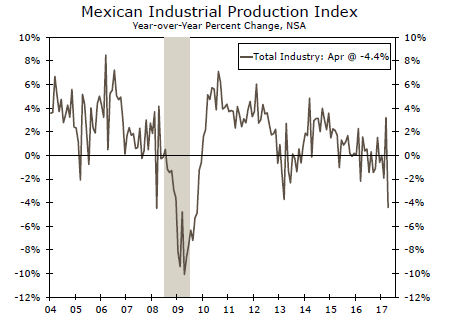
Brazil Economic Activity Index • Friday
The recent political noise in Brazil has soured an already weak expected economic performance by the largest economy in South America in 2017. Thus, the release of May’s economic activity index, a proxy for overall GDP growth in the country, will have important implications for the rest of the year after several volatile readings during the first four months.
From looking at trade data it is clear that exports have been helping economic activity during the first half of the year. However, the weakness in imports point to a still weak production and consumption environment domestically. Furthermore, the recent escalation in political tensions with the recent prosecution of the president will put further pressure on the economy, even if the process doesn’t end with any serious terminal crisis for President Michel Temer.
Previous: 0.3% (Month-over-Month)
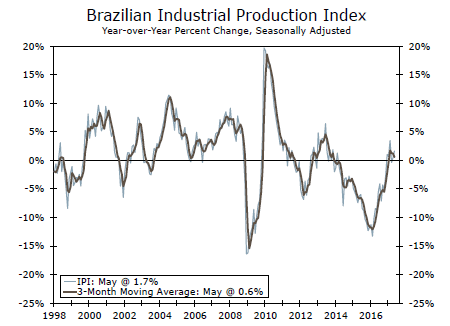
Point of View
Interest Rate Watch
Business Credit: A Demand Side View
As illustrated in the top graph, the pace of C&I lending at domestically chartered banks has certainly slowed over the past year. Yet the story is not of tighter credit standards but one of weaker demand. This weaker demand reflects the steadiness of final sales and the continued weakness in profit margins.
Slower C&I Lending: Why?
Growth in C&I lending has slowed over the last year. In fact, the current pace of lending would be consistent with prior periods of economic weakness in 1990, 2001, 2008-2009 s0 this pace is of concern to the economic outlook.
What makes this period particularly interesting is that the slowdown is not associated with a tightening of credit standards. The middle graph provides visual evidence that the net percentage of banks tightening standards for C&I loans to large and medium firms actually is a touch on the easy side. A similar graph for small firms provides the same result. So what is the story?
Lack of Demand
Slower loan growth is a demand, not supply side, story. Three factors are at play. First, the expected pace of final sales in the economy has come to reflect the steadiness of two percent economic growth over the last five years. As a result, firms already have the capacity to produce the current pace of economic output so there is no need to accelerate business equipment spending. In 2016, business equipment spending fell 0.5 percent after a gain of just 2.1 percent in 2015. Second, firms face the problem that profit margins have declined (bottom graph) and so there is less profit incentive to add to capacity going forward. Finally, control of inventories has been tight and so there is little need to borrow funds since both the real quantity of inventories has been low and little incentive exists to borrow in anticipation of higher inflation prices for inventoried goods. Inventories were a drag of 0.4 percent on growth in 2016 and are expected to add just 0.1 percent this year.
Weaker lending is often associated with tighter lending, but the pattern over the last year has been weaker demand—not supply.
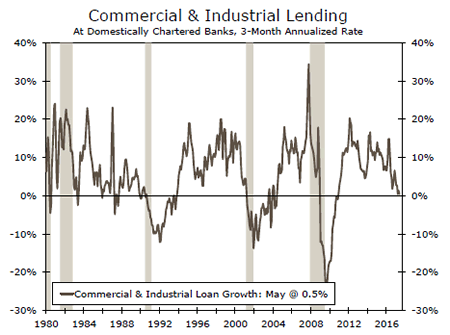
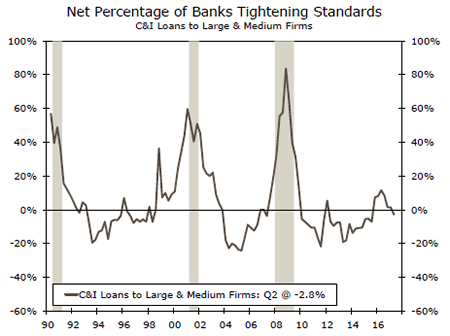
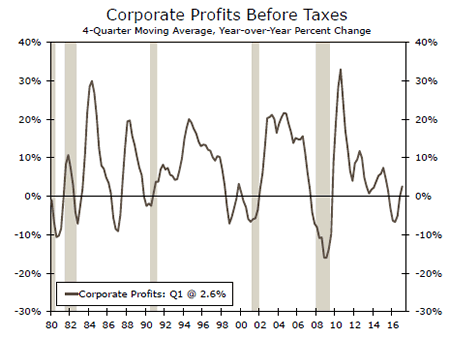
Credit Market Insights
Detailed Loan Data Provide Insight
Bank loan performance has improved dramatically since the Great Recession, and new data from the New York Fed’s "Quarterly Trends for Consolidated U.S. Banking Organizations" report provide a more nuanced look at delinquencies. In aggregate, the nonperforming loan ratio for U.S. commercial banks fell to 1.5 percent in Q4, from a recession peak of 5.7 percent. The new data, however, provide a more granular look at loan performance within the Commercial Real Estate (CRE) sector, which has been under scrutiny of late due to elevated prices.
A closer look at CRE loan performance reveals differences in lending risk within the sector. For example, loans backed by income-producing properties and properties still under construction have both receded to less than 1 percent delinquent from their recession peaks. However, the former peaked at 6 percent delinquent while the latter peaked at 17 percent.
Construction loans present higher lending risks, as they are backed by properties that have yet to produce any cash flows. Furthermore, the value of the properties is hard to forecast, particularly if CRE properties are appreciating. Indeed, CRE prices are up a steep 90 percent since 2010, and the Fed has identified this as an area of "growing concern." We will continue to monitor these metrics for signs of risk, particularly as we enter a later stage of the business cycle.
Topic of the Week
European "Taper Tantrum?"
Yields on government bonds in many European countries have risen noticeably in recent days. For example, the yield on the 10-year German Bund is up more than 30 bps over the last two weeks (top chart). Yields on comparable government securities in other European economies have risen by similar amounts, and the rise in European bonds yields has exerted upward pressure on U.S. Treasury yields. What is going on?
The meltdown in the European bond market reflects expectations that the European Central Bank may soon dial back its quantitative easing (QE) program further. These expectations have been fueled by the recent run of economic data out of the euro area, which generally have been stronger than expected, and by comments by ECB policymakers. This episode reminds us of the "taper tantrum" that occurred in mid-2013 when then-Fed Chairman Bernanke stated that the Fed would eventually begin to "taper" its bond purchases. As shown in the bottom chart, the yield on the 10-year Treasury security shot up by 140 bps between May 2013 and September 2013. Is there anything that can be learned from this earlier "taper tantrum"?
One lesson is that once bond yields start to move, they can do so quickly and for some time. So yields in Europe clearly could move significantly higher in coming months. But another lesson from the U.S. experience is that the backup in bond yields that the "taper tantrum" engendered was not sustained. Indeed, the yield on the 10-year Treasury security returned to its pre-taper level in early 2015.
The ECB is currently buying €60 billion worth of government bonds per month. We look for it to announce a reduction in this monthly pace this autumn, probably in September. But we also believe that the ECB will take its time in raising its traditional policy rates. Although government bond yields in Europe could possibly move higher in coming weeks, we believe the fallout will largely remain contained as long as the ECB does not move quickly to hike its policy rates.
